Key Moments in Western Culture
The
Holmes-Cooney Fight
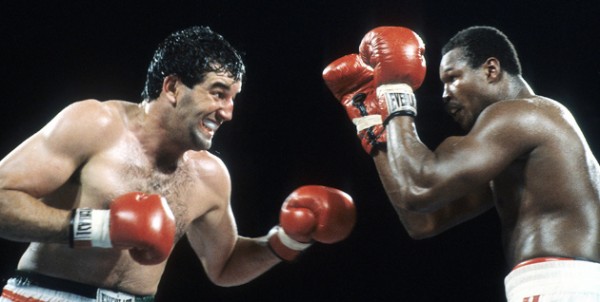
By RAR
Gerry Cooney,
like the rest of us, was living in a special space in 1982. The world
was right on the cusp of another of those seven-year cycles, in which
our experience of life goes through fundamental change, fragmenting
families and communities and further rending our sense of shared
experience. Fashions, styles, sounds, manners, behaviors, technologies,
entertainments – everything that was familiar to us in the 1970s was
changed by the time we reached the early 80s.
Our sense of modernity had
been transmogrified by the advent of cable television, and by new media
offerings like the Cable News Network (CNN), Music Television (Mtv), and
an ever-growing list of television alternatives. This would ultimately
destroy the monopoly that the legacy networks CBS, NBC and ABC had
long-enjoyed over the American television audience, and it would
marginalize what had been unifying forces for generations of viewers by
virtue of having provided all there had been to watch on television. We
had all watched major historical events together, like the events of
1963 surrounding the Kennedy assassination, followed shortly thereafter
in 1964 with The Beatles appearances on the Ed Sullivan Show, and we had
shared important cultural touchstones like “All In the Family”,
“Laugh-In”, and “Saturday Night Live”. Television had always had its
detractors, but with the proliferation of Cable TV channels, the notion
of the “boob tube” was consigned to the past, overwhelmed by a wave of
niche programming that sometimes seemed pretty smart, and in that
process a new era of media absorption was born. Television sets started
to proliferate in peoples’ homes, installed in bedrooms, kitchens, and
bathrooms. Kids, watching in the isolation of their bedrooms, would
start referencing programs that their parents had never heard of, and
would never watch. “Beavis and Butt-Head” comes to mind, and so new
models of behavior emerged.
After the dourness of the
late-70s, when the Carter Administration had encouraged Americans to
live austere lives, President Ronald Reagan represented a sense of
renewed energy in America, even if by 1982 Reagan’s Budget Director
David Stockman was beginning to call his boss a “sunshine boy” for
enacting tax cuts that would soon thereafter need to be reversed to
recover economic stability. Reagan had an overly-rosy view of America’s
economic health and promise, but he was becoming embroiled in covert
actions and an arms scandal that were of a piece with the period. There
was a sense in the early 80s that everyone had a scam going; that people
were finding ways to profit around constraints, and that winners were
making money and leaving others behind. In fact, people started to think
of low income people as something less than just mere unfortunates,
uncharitably preferring to think of them as “losers”. Cocaine had become
the sine qua non of recreational drugs, and people were enjoying that
edge. There was an embrace of money and excess, and going against that
grain felt unfashionable. Punk music, analogous in its
anti-establishment sentiment to the Folk of the 60s and early 70s, had
come and gone, but its echoes seemed to spur a counter-insurgency
expressed through synthesizers and Disco beats. Music coming out of the
United Kingdom began to dominate the airwaves, in a time when few knew
that radio was in its dying throes, soon to be replaced by Satellite
transmissions such as Sirius XM (1990). New Wave music was unabashedly
Gay, in many respects, and it contributed to a shift in public
perception and a new openness toward alternative lifestyles and
homosexuality.
The one area that seemed to
show a retrograde motion was Black-White relations, and this was
reflected in Reagan Administration policies. Reagan, for some reason,
chose to begin his 1980 presidential campaign in Philadelphia,
Mississippi, near a site where three civil rights workers had been
murdered in 1964. He appointed conservative judges Antonin Scalia and
Clarence Thomas to the Supreme Court, and from that platform he carried
out an assault on civil rights policies, including affirmative action
programs and voting rights. He slashed funding for the Comprehensive
Employment and Training Act (CETA), that provided needed assistance to
Black people. He sought a tax exemption for Bob Jones University, a
racist college, and backed Senator Jesse Helms in his assertion that
Martin Luther King was a disloyal American. Reagan popularized, among
some Republicans, the idea of black women as “welfare queens”, and he
championed the idea that Black leaders were “doing very well leading
organizations based on keeping alive the feeling that they're victims of
prejudice."
* * * *
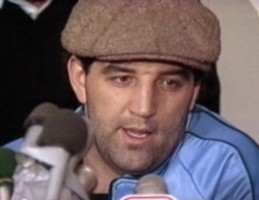 Twenty-six-year-old
Gerry Cooney was the World Boxing Council’s #1-ranked Heavyweight in
1982. A six-foot-five boxer, with a great left hook, he was well-known
in amateur boxing circles, having worked his way up from a gangly
middleweight to become a heavyweight contender. Encouraged by his father
to get into boxing, the Long Island native won two New York Golden
Gloves Championships, including the 1973 160-lb Sub-Novice Championship
and the 1976 Heavyweight Open Championship. He had won international
tournaments in England, Wales, and Scotland, and by the end of his
amateur career had compiled a record of 55 wins and 3 losses. Twenty-six-year-old
Gerry Cooney was the World Boxing Council’s #1-ranked Heavyweight in
1982. A six-foot-five boxer, with a great left hook, he was well-known
in amateur boxing circles, having worked his way up from a gangly
middleweight to become a heavyweight contender. Encouraged by his father
to get into boxing, the Long Island native won two New York Golden
Gloves Championships, including the 1973 160-lb Sub-Novice Championship
and the 1976 Heavyweight Open Championship. He had won international
tournaments in England, Wales, and Scotland, and by the end of his
amateur career had compiled a record of 55 wins and 3 losses.
When Cooney decided to turn
professional, he fell under the tutorship of veteran trainer Victor
Valle, who had six decades of experience with top-ranked fighters. He
had guided the careers of champions
Alfredo Escalera (junior lightweight),
Esteban DeJesus (lightweight), and Billy Costello (superlightweight).
Valle saw the 225-pound Cooney as a guy who could win the heavyweight
championship if he was brought along carefully, and that he did,
carefully selecting Cooney’s opponents and developing almost a
father-son relationship with his fighter. Valle used to sing “Danny Boy”
to his Irish-Catholic liege in the dressing room before fights, changing
the words to “Gerry Boy”.
“Gentleman” Gerry Cooney won
his first twenty-five professional fights, recording 19 knockouts or
technical knockouts, and along the way his managers Mike Jones and
Dennis Rappaport turned him into a media figure in the New York City
market. Cooney was doing national television commercials by 1980,
becoming known as a sort of “great white dope” because the amiable giant
had a kind of a marketable Joe Palooka quality that worked. He seemed
sweet and sensitive. Though media exposure puffed up Cooney’s celebrity
profile, in boxing circles Cooney was not viewed as a threat to any of
the top heavyweights of the time, all of whom were Black in a period
where Blacks dominated the heavyweight division.
Cooney had largely established
his winning record on easy victories over nobody fighters, though he had
also defeated some legitimate pros in Charlie Polite, former US
heavyweight champion Eddie Lopez, Tom Prater, and John Dino-Denis. What
Cooney needed to establish legitimacy as a contender were victories over
big name Black heavies, and his first stop along that journey came
against Leroy Boone. The 216-pound Boone came into the fight with 12
wins and 3 losses. He was a good fighter, though just a training step
along the way toward getting Cooney paydays with bigger names and better
competition. That said, Boone was a guy who had never been knocked off
his feet, so he would offer a challenge that Cooney, the wannabe
champion, needed to face.
Cooney was unusually tall for
a fighter of his time, preceding an era in which heavyweights would
become even bigger. Only the six-foot-nine-inch Primo Carnera came to
mind to boxing commentators who struggled to describe Cooney’s physical
profile, which was tall but lacking in muscular definition. Cooney had
that kind of body that just does not get buff. He didn’t look like a
boxer, in many ways, or even like a guy who hit the gym regularly. He
seemed to have more hair on his chest than he had biceps or triceps,
and perched atop long, skinny, white legs, Cooney seemed cartoonish,
like a caricature of an old school pugilist. His looks were deceptive,
because he was devastatingly powerful and carried a pulverizing punch.
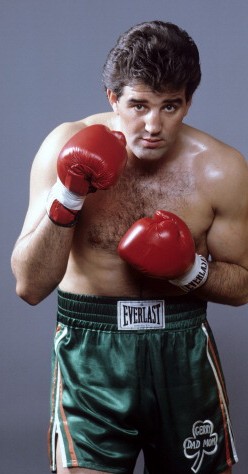 Cooney
entered the ring against Boone wearing emerald green trunks, which
boasted an Irish shamrock emblem. The buzz in the arena was electric and
in their corners both fighters pawed the matt like bulls readying to
charge, obviously affected by the enthusiasm of the crowd. The fight got
off to a miss-start when Boone and Cooney engaged before the opening
bell, and they had to be chased back into their neutral corners to start
the fight again properly. Cooney
entered the ring against Boone wearing emerald green trunks, which
boasted an Irish shamrock emblem. The buzz in the arena was electric and
in their corners both fighters pawed the matt like bulls readying to
charge, obviously affected by the enthusiasm of the crowd. The fight got
off to a miss-start when Boone and Cooney engaged before the opening
bell, and they had to be chased back into their neutral corners to start
the fight again properly.
As Gerry Cooney was rising up
through the amateur weight classes, he had been trained stylistically to
fight as a “boxer”. Styles mean everything in boxing, and fighters
develop their skills along certain well-defined lines of discipline,
based on what they bring to game. Some are “sluggers”, like Mike Tyson,
whose style was all about extreme aggression and knockout power. Many of
those types will work inside to the body, but there are perimeter
sluggers, as well, like a Tommy Hearns. Other fighters are “tacticians”,
like Evander Holyfield, who analyze their opponent’s skills and adjust
their game accordingly, fighting inside and out. The “boxer” is often
the showiest of the lot, which is what made Cooney’s choice to fight in
that style seem so odd. Muhammad Ali, Sugar Ray Leonard, and Floyd
Mayweather, Jr. were boxers. Those guys were extremely athletic, quick
and agile, none of which are traits one would ever associate with the
lumbering Gerry Cooney, and yet there he was, a graceless giant fighting
cautiously from the outside of the reach of his shorter opponents.
Cooney used his long left jab to steadily wear down the defenses of his
combatant, patiently waiting for an opening to step in and to the left,
and then to throw his trademark left hook.
Cooney was geared to deliver
his left as a hybrid punch, part upper cut, that could be aimed at the
jaw, but was often delivered with devastating effectiveness to his
opponent’s liver. It seemed as if he had been physically gifted for this
one punching motion, when his body mechanisms miraculously worked in
perfect unison to create a brief moment of ultra-violence. It was the
punch that you always knew was coming from Cooney, the inevitable
punctuation at the end of each brutally long sequence of jabbing
statements.
For most of the first four
rounds of the Leroy Boone fight, Cooney was satisfied to patiently
deconstruct Boone’s defenses, firing his heavy jab right through Boone’s
gloves, held high before his face. Boone was hoping to counterpunch,
because he saw what a lot of fight fans saw, which was that Cooney was
not a great defensive fighter. Cooney wasn’t that quick, and if you
could get inside his reach, you could find opportunities to land high
and low, and late in the fourth round Boone launched such an inside
attack.
Boone nailed Cooney with a
barrage of well-directed shots to the head but Cooney didn’t fold, and
so there answered was the big question that hangs over the heads of
every heavyweight fighter: can he take a big punch? Cooney had shown
that he could, at least one coming from Leroy Boone.
Cooney not only took the
punches, but he returned a barrage of his own, and when he returned to
his corner at the end of the round he seemed visibly to be enjoying
himself. It was as if Boone’s assault had snapped him out of a sleep
state and the brawler within him had been happily awakened.
However much Cooney may have
wanted to go into full attack mode, the Boone fight showed that he was
an uncommonly disciplined fighter. In the fifth round, Cooney resumed
the patient sparring style that had characterized most of the fight up
to that point, other than for the last minute of the previous round.
What did change was that Cooney started setting down on his left hook,
digging hard to Boone’s mid-section, and occasionally firing an
effective straight right. Almost exclusively a left-handed power
puncher, Cooney’s right was an arm punch that he could spot effectively,
but it lacked knockdown power.
In the sixth round, Cooney
resumed his patient demolition of Boone until a left hook to the liver
caused Boone to double in pain, and for the referee to call an immediate
halt to the fight. Cooney had destroyed a legit Black heavyweight, and
he was ready to move up in class.
* * * *
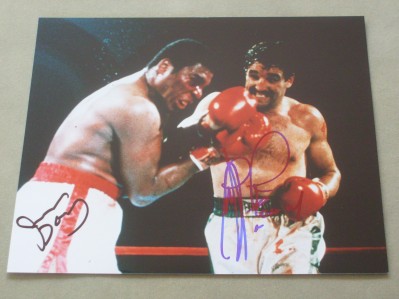 Jimmy
Young had been fighting professionally since 1969, and he was a talented
tactician who had lost a disputed title decision to Muhammad Ali in
1976. As a fighter, Young was called “the cutest guy in the business”
for his expert ring generalship. He surprised opponents, lulling them
into traps and striking with athletic precision. Young could only be
beaten by best-in-class fighters, and in a long career that included 19
losses his record reads like a history book of his era of boxing. All
the big names are there. Jimmy
Young had been fighting professionally since 1969, and he was a talented
tactician who had lost a disputed title decision to Muhammad Ali in
1976. As a fighter, Young was called “the cutest guy in the business”
for his expert ring generalship. He surprised opponents, lulling them
into traps and striking with athletic precision. Young could only be
beaten by best-in-class fighters, and in a long career that included 19
losses his record reads like a history book of his era of boxing. All
the big names are there.
By the time Young fought
Cooney in 1980, he was well-past his prime and he lacked the power to go
toe-to-toe with any of the heavyweights of the era. He was, however, a
highly-respected pro and another important step along the ladder in
Cooney’s ascendancy in the division.
Young came into the fight in
good condition, his career on the line. Cooney came into the fight with
a mustache, which made him look like a guy from the bare knuckle era of
boxing.
In the first round, Cooney
attempted to box with Young as he had with Leroy Boone, but Young was
too savvy. He parried Cooney’s jab and then worked inside, landing shots
before darting back out of danger, and robbing Cooney of the tactic
known to work against Young, which was to go to his body. Cooney
couldn’t get there, but rather was reduced to missing shots to Young’s elusive chin,
and that pattern continued through the second round.
At the end of round two,
Cooney’s corner men complained that Young had thumbed their fighter in
the eye, and Cooney came out for round three with aggression. Young
smothered Cooney’s attack, and Cooney went back to his pattern of
jabbing, while Young kept ducking inside and scoring.
Late in round three, Cooney
fired an upper cut that caught Young on the brow and opened up a cut
above his right eye, and Young seemed immediately to be in trouble.
While Young shook his head, trying to clear his vision from the blood
running down his face, Cooney pounced for the kill, firing a barrage of
combinations, some of which got through Young’s cocooning defense.
With a minute left in the
round, Jimmy Young started landing low blows, probably intended to stop
Cooney’s assault, though he did not get a warning from the referee.
Young backed Cooney into a corner and controlled him, lasting out the
round.
Cooney came out aggressively
in round four and while Young exchanged with him he became blinded by
the blood pouring into his eyes. Young’s corner called the fight at the
end of the round, and so Gerry Cooney had faced a difficult challenger
and prevailed on the strength of his lethal uppercut.
Cooney came away a richer and
wiser man. He had learned the value of the well-timed low blow, which
was a sneaky add to his fighter’s tool kit. Cooney’s uppercut left had a
way of landing south of the beltline without drawing the attention of
referees: a good trick to have in his bag in the event that an opponent
needed to be slowed.
* * * *
Ron Lyle was a Denver-based
fighter with a 39-6-1 record when he faced Cooney. A former gang member,
he had done seven-and-a-half years in the Colorado State Penitentiary
for second degree murder before starting an amateur boxing career,
eventually turning pro. Lyle was a big puncher who had scored victories
over big names including Jimmy Ellis and Ernie Shavers. And, if Gerry
Cooney’s marketability as a heavyweight contender was contingent upon
him beating a big-name Black fighter, Ron Lyle was at the very heart of
that darkness.
Lyle came into the fight at
6’3½” tall and 211 pounds. He turned out to be exactly the kind of
fighter whose style would be neutralized by Cooney’s outside game. Where
Jimmy Young had been able to game Cooney and get inside, Lyle looked
lost, floundering from afar and taking jabs, along with Cooney’s deft
left-upper cut and his occasional straight right to the body. In the
last minute of the first round, Cooney moved Lyle into the ropes and he
delivered a steady, patient barrage of right and left hooks to the body
and the head, and with only seconds left he delivered a left-hook to
Lyle’s liver that caused Lyle to collapse between the ropes, draping
onto the apron, finished.
* * * *
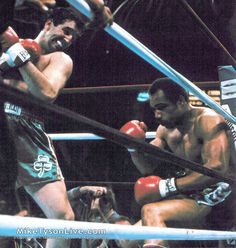 Gerry
Cooney often seemed like a one-handed fighter, like all he could do was
throw his left. His right was accurate, but of a lesser order in his
arsenal, and that was because he was a left-hander by nature. Somewhere
along the way, someone had trained him to fight orthodox, but his
dominant arm remained his left, so he had the perfect weapon to use
against a right-handed opponent. Gerry
Cooney often seemed like a one-handed fighter, like all he could do was
throw his left. His right was accurate, but of a lesser order in his
arsenal, and that was because he was a left-hander by nature. Somewhere
along the way, someone had trained him to fight orthodox, but his
dominant arm remained his left, so he had the perfect weapon to use
against a right-handed opponent.
Cooney’s demolition of Ron
Lyle had earned him the kind of respect that he needed to leverage his
celebrity and gain a shot at a heavyweight title. He had one person left
to get by to reach the #1 rank in the WBC and thereby get a mandatory
shot at the title held by Larry Holmes.
Ken Norton, who had been
fighting professionally since 1967, was the guy who Holmes beat to win
the WBC title that Cooney now wanted. Hollywood handsome, Norton became
nationally known by having beaten Muhammad Ali, breaking Ali’s jaw in
1973 before losing in two rematches. He was on the down side of his
career by the time he met Gerry Cooney in May, 1981. It would be
Norton’s last fight.
Cooney came out quickly and
tagged Norton with a straight right, following up with a barrage of left
hooks and rights until, 54 seconds into the first round, Norton was put
to sleep, slumping onto the bottom rope like a guy waiting for a bus.
* * * *
Gerry Cooney had earned his
shot at Larry Holme’s World Boxing Council Heavyweight Championship
belt, but the champ was going to make him wait for it.
 Fighting
professionally since 1973, Larry Holmes had beaten every big name
fighter of his era. This included Ernie Shavers, Ken Norton, Mike
Weaver, Alfredo Evangelista, Ossie Ocasio, Lorenzo Zanon, Muhammad Ali,
Trevor Burbick, Leon Spinks, and Renaldo Snipes. Despite this
extraordinary record of accomplishment – he was 39-0 when he met Cooney
– Holmes was never accorded the level of respect that had been accorded
other great heavyweights, most notably Muhammad Ali. Fighting
professionally since 1973, Larry Holmes had beaten every big name
fighter of his era. This included Ernie Shavers, Ken Norton, Mike
Weaver, Alfredo Evangelista, Ossie Ocasio, Lorenzo Zanon, Muhammad Ali,
Trevor Burbick, Leon Spinks, and Renaldo Snipes. Despite this
extraordinary record of accomplishment – he was 39-0 when he met Cooney
– Holmes was never accorded the level of respect that had been accorded
other great heavyweights, most notably Muhammad Ali.
In truth, Holmes suffered by
being directly comparable to Ali, which made him seem more like an
imitator than a visionary boxer. Holmes had been Ali’s sparring partner
and had clearly gone to school on Ali’s moves. Ali had spotted Holmes
when the younger fighter was an amateur and Ali had brought Holmes to
Ali’s training site in Pennsylvania, where he paid him $500 a week to
work as his sparring and training partner. The two had similar size and
range, and they were of similar skill levels. Ali knocked out 61 percent
of his opponents, while Holmes knocked out 59 percent of his.
Where the mentor and protégé
differed was in the area of charisma. Even as he was defeating the
biggest names in the profession, Holmes demonstrated a dispassionate,
disengaged, workman-like attitude that seemed flat and boring, while
also more than a little condescending. He often seemed disrespectful of
his opponents, while he only occasionally flashed his own considerable
skills in any impressive display of boxing artistry. None of this
endeared him to the boxing world, and he was frustrated by their
displeasure, once verbally attacking one of boxing’s most cherished
personalities, proclaiming that Rocky Marciano couldn’t have carried his
jockstrap.
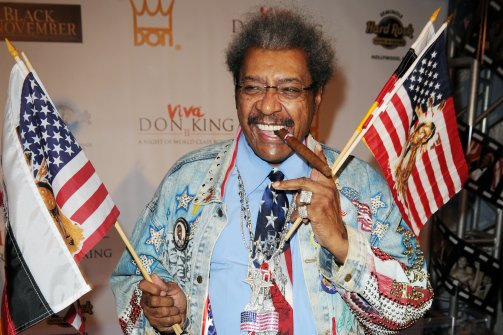 To
get to Larry Holmes, you had to go through Don King. To
get to Larry Holmes, you had to go through Don King.
Holmes was a principal asset
to Don King promotions, which presented Holmes’ fights in his
championship years. Holmes always said that he never made any money in
boxing until he became associated with Don King, but the flamboyant King
came with a lot of baggage. King had dropped out of Kent State
University to run a bookmaking operation. He had killed two people, one
ruled a justifiable homicide, while the second got him a second degree
murder conviction. He had stomped an employee to death over a dispute
involving $600. King was to spend four years in prison, but letters of
recommendation from Jesse Jackson, Coretta Scott King, George Voinovich,
Art Modell, Gabe Paul, and other high profile celebrities earned him an
early release. Resurfacing as a boxing promoter, he promoted the careers
of Muhammad Ali, Joe Frazier, George Foreman, Larry Holmes, Mike Tyson,
Evander Holyfield, Julio César Chávez, Ricardo Mayorga, Andrew Golota,
Bernard Hopkins, Félix Trinidad, Roy Jones, Jr. and Marco Antonio
Barrera. Almost all of those fighters would eventually sue him for
defrauding them, but King settled most lawsuits with pay-offs and
avoided felony fraud convictions.
King’s ethics problem extended
to the narratives that he was willing to spin to promote his big money
bouts. He was a marketer, a brand builder, who gave the world "The
Rumble in the Jungle", the "Thrilla in Manila", and other recognizably
branded events.
King’s promotional strategy
for the Holmes-Cooney fight was a sign of the times, and an example of
gross irresponsibility in the pursuit of riches. King is still around
today, a Donald Trump endorser who thinks Bernie Sanders should be
Trump’s Vice President. Like Trump, King would throw gasoline on an out
of control fire if he thought it would get media coverage, and that is
exactly what he did in marketing the Holmes-Cooney championship fight.
King promoted the fight as a
racial spectacle, a disrespected Black champion going against a Great
White Hope. No White man had held the heavyweight title for 22 years at
that time, and King toured Holmes and Cooney around the country to
attend press conferences and promote the clash. The media darling Cooney
was on the cover of Time Magazine. Celebrities became obsessed with the
event, as did White supremacist groups who announced that they would
have snipers at the event to shoot Holmes as he entered the ring. That
prompted Black groups to announce that they would have armed members on
hand to defend Larry Holmes from attack.
By the time Holmes and Cooney
met, in the parking lot at Caesar's Palace, police snipers were
positioned on the roofs of all of the hotels surrounding the event site,
ready to respond if any of the proposed violence actually happened.
* * * * *
In a new age of hyper media,
and in a period when race relations were in a difficult new phase,
Holmes and Cooney became pawns in an evil enterprise; one that exploited
xenophobic fear using powerful new tools of audience manipulation. Larry
Holmes, in the Don King narrative, came to symbolize a Black community
that the White world would not recognize, and would not allow to achieve
its potential and its promise. Cooney, dubbed the Great White Hope,
became symbolic of dumb White America, and the segment of White society
most threatened by upwardly mobile Blacks. Cooney had been uncomfortable
with the fight promotion, saying that race had nothing to do with the
fight, that “we are all Americans” and so he won the broader PR battle
as the fight date approached, but there were complications. Tension
between the Cooney and Holmes camps grew more personal until finally
there was public acceptance of the notion that Cooney and Holmes hated
each other. That helped turn the event into a box office bonanza,
including a closed-circuit Pay Per View revenue stream for the live
fight, and rebroadcast rights sold to HBO, which ran the fight a week
later.
Eleven months passed between
the time that Cooney beat Ken Norton and the date when he finally got
his crack at Holmes. Part of the period of inactivity was intentional,
with Cooney avoiding tune-up fights for fear that a wildcard loss would
cost him his shot at Holmes’ title. Other delays were health related, as
at one point the fight was scheduled and then rescheduled for a later
date after Cooney hurt his shoulder in the gym. Some fight fans opined
that Cooney was scared, looking for an excuse not to fight Holmes, and
so the tension between the two fighters continued to grow. While Cooney
was sitting on pins and needles, biding his time, Holmes fought and beat
two more name opponents: Leon Spinks, who had beaten Muhammad Ali, and
Renaldo Snipes, who knocked Holmes down before finally losing to him.
That incident created doubt in some that Holmes, at 32, was still the
real deal, despite his unbeaten record. After Snipes, Holmes went into
the gym for six months of preparation before he finally met Gerry Cooney
for the WBC Heavyweight Championship.
* * * * *
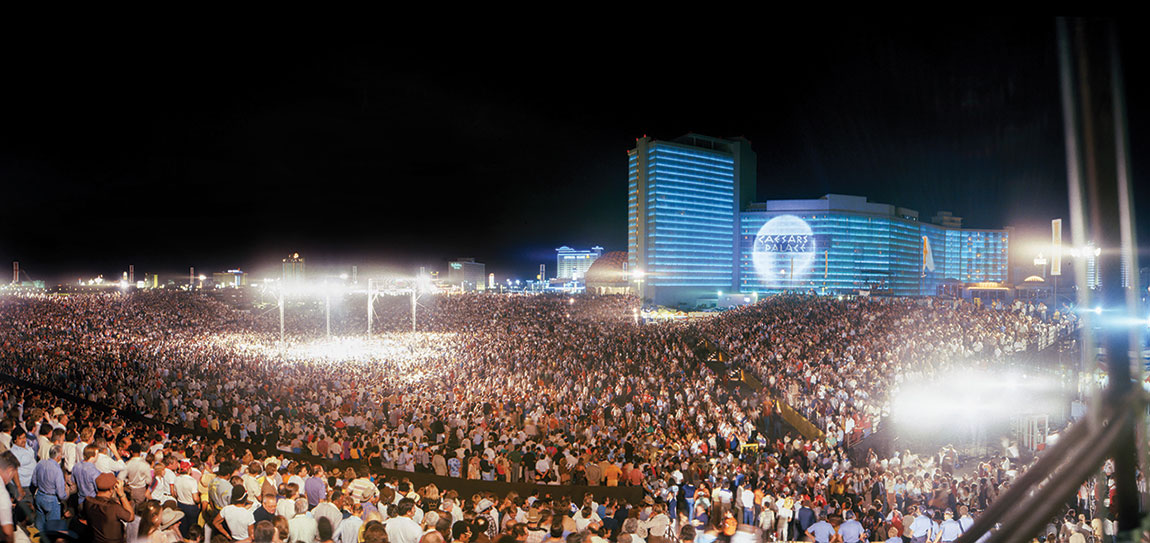
On June 11, 1982, Gerry Cooney
entered the outdoor arena at Caesar’s Palace in Las Vegas, where the
temperature at fight time hovered at more than 100 degrees, to the theme
from the fight film Rocky. He had grown in his public stature and
become the fan favorite, though he was the underdog in the fight. Fight
analyst Howard Cosell touted Gerry Cooney as being 6’7” and taller than
the aforementioned Primo Carnera, which was probably based more on
Cosell’s perception of the magnitude of the fight than on any late
growth in the still-young Cooney. Dressed in Irish green, Cooney entered
the arena, addressing fans along the way, cracking jokes and seeming to
be relaxed. Holmes entered to the Disco sounds of “Ain’t No Stopping Us
Now”, trotting down the aisle to the ring, apparently anxious to get on
with the contest that he had predicted he would win in 7 rounds, or
maybe in 4 if Cooney engaged him.
Diminutive Nevada District
Attorney Mills Lane, who had officiated many championship fights, was
the third man in the ring and he looked tiny standing between the two
big heavies. Announcing the fight for HBO, Howard Cosell wondered if
Lane would be physically large enough to control the two fighters.
Waiting in their corners for
the bell to sound, signaling the start of the first round, Holmes
bounced up and down like a giant spider monkey, while Cooney rocked back
and forth like a gorilla in a zoo cage.
ROUND
ONE: At the bell the two fighters approached and they
immediately fell into a pattern that would characterize much of the rest
of the fight, with Cooney coming forward, Holmes moving adroitly left
and right, firing jabs and moving; Cooney jabbing, hooking, sometimes
connecting.
For the first half of the
first round, Holmes looked too fast and accurate for the patiently
plodding Cooney, but then Cooney landed a left to Holmes body and the
fight started to change. Cooney threw a right to the body and then
landed a left below the belt. It appeared unintentional, but shortly
thereafter it happened again. Cooney threw hooks to Holmes’ ribs that
Holmes blocked with his arms, leading Howard Cosell to suggest that
Cooney’s power could make Holme’s limbs grow numb, as Rocky Marciano had
been known to do to opponents feeling his thunderous barrage.
Cosell’s invocation of
Marciano’s name played to the narrative for the event, that this was a
fight between an unpopular Black champion, who had insulted a beloved
White champion, and a Great White Hope who was calling him to account
for his actions.
It seemed apparent in the
first round that Holmes felt and was affected by Cooney’s power. He
switched his tactic, limiting his exchange to jabs and staying away from
Cooney, obviously uncomfortable with letting Cooney get to his body.
Just before the end of the round there was a flurry in which Holmes
landed a shot squarely on Cooney’s jaw, and it didn’t seem to hurt him
at all. Holmes must have returned to his corner wondering, if Cooney
survived that shot, how he was going to keep the Irishman at bay.
Between rounds, Cooney’s
mentor Victor Valle implored him to use the double jab, and he warned
Cooney against wild exchanges with the champ. “This guy isn’t shit!”
Valle told his fighter, but “be patient!”
ROUND TWO:
For most of Round 2, Holmes circled
Cooney, firing jabs, avoiding Cooney’s right leads, jabs, and left
hooks, but mostly avoiding the ropes. Cooney had a reputation for
destroying opponents that he could trap on the ropes, and Holmes kept
moving laterally to negate Cooney’s attack, stopping occasionally to
fire a sharp volley, before moving again. Then with a little more than a
minute left in the round, Holmes nailed Cooney with an overhead right
that sent Cooney lurching to the canvas. It looked like the doubts the
fight world had about the upstart Gerry Cooney – the Great White Dope –
were going to be well founded, but Cooney wasn’t done.
With 30 seconds left in the
round, Cooney stood up on rubbery legs, looking like a guy who might be
ready to go, but he suddenly recovered himself. Cooney seemed to clear
his head and as the round drew to an end he seemed to take control over
Holmes, firing jabs and lead rights and clearly winning the final
half-minute of the round.
My take, when the fighters
went to their corners, was that Holmes probably had a 10-9 and a 10-8
round on his ledger, a 2-0 lead in rounds, and was well on his way to
defending his title.
ROUND
THREE: At the start of Round 3, Holmes
squared up with Cooney and the two exchanged jabs until Cooney once
again landed a below the belt shot that made Holmes go back to his
circling strategy. Cooney scored again to the body, again landing a shot
that appeared low, and Holmes was clearly uncomfortable with those body
shots. He stayed at such a range that he couldn’t land his own long jab,
but Cooney pressed him and at one point he landed a series of left hooks
to Holmes’ head and the look on Holmes’ face turned to one of real
concern. Cooney began to stalk Holmes, landing another low blow that
seemed to warrant a warning from Mills Lane, but none came. Cooney
continued to score, following Holmes around the ring, and Holmes seemed
to be losing control of the fight. Bruising appeared around Holmes right
eye, where he had been absorbing Cooney’s hook. After getting nailed
with an uppercut left, Holmes began to fight back in an effort to regain
advantage, standing in front of Cooney and looking for another
opportunity to land his overhand right, which he did at one point but to
no great effect. Cooney won the third round, so by my estimation was
down 29-27, 2 rounds to 1.
ROUND FOUR:
Holmes came after Cooney to start the
fourth, standing flat-footed in front of him and looking to exchange
until Cooney again caught him with a shot to the body that made Holmes
decide to resume his jab-and-move game. Occasionally he would set for an
exchange but Cooney kept scoring, particularly with his much
under-appreciated right hand. Cooney was getting off first and it seemed
to throw Holmes out of his rhythm. For the last 30 seconds of round 4
Cooney landed to the body and head and when Holmes went back to his
corner he looked deflated. On my card, Cooney had pulled even in rounds,
and was down only 38-37 in points under the 10-point must system.
ROUND FIVE:
Cooney was clearly gaining in
confidence, and he practically leaped out of his corner at the start of
Round 5, going after Holmes with his stiff jab. Fight commentator and
former Welterweight Champ Sugar Ray Leonard surmised that the age
difference was beginning to show, as the 25-year old Gerry Cooney seemed
energized while the 32-year old Larry Holmes was looking a little tired
and a lot like a guy who didn’t want to get hit anymore.
For the first two minutes of
Round 5, Cooney stalked Holmes, nailing him with jabs and body shots as
Holmes retreated away, firing almost no punches at all, obviously
reluctant to do anything other than defend against Cooney’s measured
onslaught. Inside the one-minute mark, Holmes scored with a couple
overhand rights, one as solid as that which had floored Cooney in the
second round, and then with fifteen seconds remaining Holmes threw a
nifty left-right and spin-away combination that seemed to remind him
that he had skills. After getting beaten for most of the round, Holmes
finished the 5th bouncing on his toes and looking like a re-energized
guy. On my score card, the fight was 47-47, with Cooney winning 3 rounds
to Holmes’ 2.
ROUND SIX:
Round 6 felt much different from how
rounds 3 through 5 -- the Cooney rounds -- had felt. Holmes had clearly
experienced some shot of energy and confidence, and he came out in Round
6 looking in charge. As discoloration grew around Cooney’s left eye,
Holmes exhibited athletic quickness, using his deft jab, and moving,
neutralizing Cooney’s attack. But then, about a minute into the 6th,
Cooney nailed Holmes with a right that made Holmes’ legs go rubbery for
an instant, and then Cooney moved into stalking mode again while Holmes
went into retreat. He landed a right into Holme’s ribs that sounded like
a bass drum and you could see energy drain from Holmes’ aging body.
Cooney won exchanges with
Holmes, but with 30 seconds left in the round Holmes landed another
overhead right that made Cooney’s legs go rubbery. He staggered around
the ring as Holmes continued to pummel him, almost going through the
ropes at one point before he was able to grab hold of Holmes to stop him
from throwing punches. When they broke, Holmes went for the kill but as
the bell rang at the end of the round Cooney landed a left that sent him
back to his corner thinking he could still win.
Round 6 might have been scored
a draw, which would have made it 57-57 as the two fighters went to their
corners to prepare for the 7th round of a scheduled 15 round
fight.
ROUND
SEVEN: Cooney came out for Round 7 with
Vasoline covering a cut by his left eye and he was ready to exchange. He
threw a beautiful straight right that just missed, but then hit Holmes
with another low left hook that finally got him a warning from Mills
Lane. It had the effect it had all fight, as Holmes retreated and moved
rather than standing in one place to take more punishment. The two
exchanged at the center of the ring before Cooney landed another left
hook to Holmes’ body that again echoed like a bass drum. He followed
with two more and Holmes retreated, staying at a distance, often
carrying his hands low until Cooney pulled back within range. Cooney
nailed Holmes with another hook to the body, but instead of wilting
Holmes suddenly started bouncing on his toes, again showing an
inexplicable ability to re-energize, at least in spurts.
Cooney kept coming, despite
Holmes show of confidence, and he scored with both hands while Holmes
missed with a winging right before getting caught with another low blow
that brought another warning from Mills Lane. In truth, Cooney should
have been penalized by this point, because he had been landing low blows
all night, and it had been having a significant influence on the fight
with Holmes retreating to recover after each blow, becoming ineffective
as an offensive force in the process.
I believe the 7th
round could have been scored even: 67-67, with Cooney still ahead 3
rounds to 2.
In Cooney’s corner, Valle
implored Cooney to get inside of Holmes’ jab, to crouch and go in low,
which was not really his fighter’s forte. Cooney’s cut near his left eye
was not looking good, and Valle feared the doctor would stop the fight
before Cooney could stop Holmes.
ROUND
EIGHT: In the 8th, Cooney
kept coming forward, trying to move in on Holmes, who continued to
circle outside, sometimes stopping but losing brief exchanges before
going back on his bicycle. Cooney landed body shots, and right leads to
the head, but Holmes didn’t seem hurt by them as he had in the earlier
rounds. It seemed as if the steam was going out of Cooney’s punches, but
he kept coming forward in a patient, deliberate way, and firing big
shots.
In the last 20 seconds of the
round, both fighters landed but neither seemed affected by the other’s
power.
Round 8 had Cooney landing
more shots. He may have moved ahead 4 rounds to 2, and 77-76. On the
other hand, Holmes was giving the impression that he was fresher and
under control, so who knows, the judges may have seen it differently. As
it turned out, it wouldn’t matter.
ROUND NINE:
In the opening moments of the 9th
round, Cooney nailed Holmes with shots to the head, but Holmes didn’t
seem to be hurt by them, and then Cooney’s cut opened and blood started
pouring down the left side of his face. Cooney attacked with a
combination, perhaps sensing that his ability to remain vital was
draining away.
At the 1:30 mark in the round
it began to appear that Cooney couldn’t see out of his left eye, and
Holmes hit him with a lead right. Cooney kept coming, but most of his
shots were being blocked by Holmes’ arms, held high between them. Cooney
landed a left hook to Holmes’ jaw that in the early rounds might have
removed his head, but at 1:20 in the round he was no longer feeling that
Cooney had any power remaining.
With about a minute left,
Larry Holmes landed a straight right, which for some reason caused Mills
Lane to rush between them to look at Cooney, perhaps expecting to see a
need to stop the fight and have the cut looked at. Inexplicably, he
darted away as quickly as he had come between them, and the fight
continued.
With less than 30 seconds left
in the round, Cooney hit Holmes with a left hook way south of the belt
line and Holmes doubled over in pain. Mills Lane jumped back in to pause
the fight to give Holmes time to recover, and to send the fighters to
their corners.
While Holmes was in his corner
recovering from the foul, his trainers gave him water and doused him to
refresh him, while all the while Cooney stood on the other side of the
ring getting no aid at all, and looking like a guy who had been in a car
accident. His face was bruised into a darkening blue mask of damaged
flesh, but he stared hard at Holmes like a guy who was on a mission and
who was prepared to go out on his shield.
Holmes seemed fine when the
fight resumed, and Cooney came right after him, throwing power hooks and
a right, not with the zip he had earlier, but still threatening.
Cooney probably won the round,
but a point penalty for the low blow made it even. On my card, Cooney
was leading 86-85, with Cooney up 5 rounds to 2.
In the corner, Cooney
expressed concern about his cut, to which his trainer said “Don’t worry
about it.” In Holmes corner they pleaded “Don’t let this guy take it
away from you!”
ROUND TEN:
At the start of the 10th,
both fighters exchanged, with Holmes landing a good straight right and
Cooney taunting him before returning a volley of punches. The two
exchanged until Cooney got the better of it, landing two more low blows
in the process, and Holmes retreated and then put Cooney in a bear hug.
Cooney landed a straight right
but though it was on the chin, Holmes didn’t move. They exchanged jabs,
and then Cooney landed another combination that included low blows to
the body. Cooney seemed to get stronger and he hit Holmes with some
shots that jarred him. In fact, in Round 10 Cooney was landing punches
at something like a 4-to-1 ratio to those landed by Larry Holmes. At one
point, Cooney landed eight consecutive shots before Holmes suddenly
nailed him with a lead right. The two exchanged big blows, with Holmes
landing four giant right hooks to the head in the final 20 seconds, but
Cooney kept throwing and landing.
When the bell sounded for the
end of the round, the two fighters brushed against one another and
touched gloves in a way that said these two now had each other’s
respect, however much bile may have been spewed in the buildup to the
event. Gerry Cooney had proven to the world that he was no bum. And
Larry Holmes had shown what had always been undeniable about him, which
was that under that dispassionate demeanor beat the heart of a lion, the
will of a champion.
The round may have been even,
which would have made the score 96-95 Cooney, with Cooney still up 5
rounds to 2.
ROUND
ELEVEN: Cooney’s corner did a tremendous
job on the eye, and he came out for Round 11 looking better than he had
in a few rounds. The two came together and exchanged punches. Cooney hit
Holmes with another low blow and Mills Lane immediately deducted another
point from Cooney’s score.
Holmes seemed to rest for the
first two minutes of the round, with Cooney firing and scoring while
Holmes was satisfied to play defense, marshall his energy, and watch for
an opening for the lead right, which had been his best punch all night.
Cooney continued to fire and score, landing a couple more low shots that
got him another lecture from Mills Lane. Then, with 30 seconds left in
the round, Holmes went on the attack with an eye on stealing the round,
but he wasn’t effective. Cooney was fighting better defensively than
anybody thought he could, slipping Holmes’ big punches.
If the round went to Cooney,
he was up 106-104 and 6 rounds to 2.
I noticed a minor change in
Cooney in Round 11. Tired, he began to have moments where he would come
out of his fighter’s stance, moving his right foot forward so that he
was squared up with Holmes, which put him in a bad defensive position.
Sometimes tired bodies don’t behave the way you would want, and Cooney’s
was starting to have a mind of its own.
ROUND
TWELVE: When Round 12 began, Cooney was
still slipping into that stiff-legged, upright posture, not really a
fighting stance but rather a pose his body chose for him out of physical
exhaustion. Cooney began punching in slow motion, and Holmes saw that
and he sharpened his jabs. Cooney kept coming, occasionally surprising
Holmes with a rapid combination driven by energy that seemed impossible
for Cooney to summon, and yet there it was.
In the last 15 seconds of the
round, Holmes reopened Cooney’s cut, hitting him with six hard lead
rights.
Holmes probably won the round,
pulling within one to 115-114, trailing 6 rounds to 3, with 3 even.
In Cooney’s corner, Victor
Valle pleaded with Cooney “to get rough with this guy”, as if the
previous 36 minutes of low blows and shots to Holmes’ head had been mere
introduction. In Holmes corner he was told, frankly, “We need these
rounds!”
As Cooney rose from his stool,
Victor Valle chided, “You waited too long for this guy!” It was as if he
knew the moment had passed.
ROUND
THIRTEEN: It was still 89 degrees when
the fighters got slowly up from their stools to start the 13th round.
They resumed the same steady, patient exchange of firepower that they
had exhibited the whole fight, with Holmes landing a shot and Cooney
coming right back with more.
Cooney’s face looked a mess
again, his cut torn back open by Holmes’ jab. The two fighters kept
exchanging big shots and then suddenly, visibly, all of Cooney’s
remaining power drained from his body and he appeared to be staggering,
out on his feet.
Holmes saw it and attacked,
landing combinations for the first time all night. Cooney lost his
balance and fell back into the ropes.
Mills Lane stepped in,
apparently to start a knockdown count though Cooney had never gone to
the matt, but before he could start it Cooney’s trainer Victor Valle
leaped into the ring with a white towel and stopped the fight himself,
saving his Gerry Boy further damage.
Larry Holmes had successfully
defended his WBC Heavyweight Championship.
Celebrating in Holmes corner
were Don King and Jesse Jackson.
POST-FIGHT: “I’m still the baddest heavyweight in the world
and it’s time for you to give me some credit,” Holmes said to the fight
analyst Larry Merchant in a post-fight interview. Holmes spoke
respectfully of Cooney’s all-around fighting skills, suggesting only
that he needed to improve his chin. The fight, after all, had come down
to one thing: Larry Holmes’ ability to survive the shots of a super
heavyweight. Holmes spoke articulately about having followed through on
his plan to counter Cooney’s punches. “I think I mastered everything
that Gerry Cooney had,” he told Merchant. “I am a great boxer, Larry,
and the world know (sic) it.”
Cooney was humble after the
fight, respectful. “Larry Holmes is the champion of the world,” he
acknowledged. Cooney said that going into the 13th round told
him that he could be a 15-round fighter, meaning someone who could fight
for championships, but something about Cooney’s quiet and sensitive
little boy voice seemed to say that he was done, that this fight with
Holmes had been it for him. It would be 27 months before he would fight
again, beating the undefeated Phillip Brown by TKO. Two months later, he
beat another good fighter, George Chaplin, also by TKO. Cooney then
disappeared for another year-and-a-half before knocking out another good
fighter, Eddie Gregg. A year later he lost to the undefeated Michael
Spinks, before fighting one last time, 30 months later, against the
resurgent George Foreman. He lost those fights by technical knockout and
then retired.
Whatever pressures Holmes and
Cooney must have felt, and however much they had been encouraged by
their promoters to disparage one another, both came away from their
fight with a genuine mutual respect. Both fighters confronted their
doubters and performed at levels beyond what anyone could have
reasonably expected. Heavyweights don’t usually throw and land the
number of punches that Holmes and Cooney had. There in the parking lot
of Caesar’s Palace they put on a show for the ages.
As a media event,
Holmes-Cooney mercifully ended with all the flash of a Sunday dinner
with grandma, with everyone being civil and polite. As a fight, it
earned its spot right up there with the most memorable in the history of
the heavyweight division.
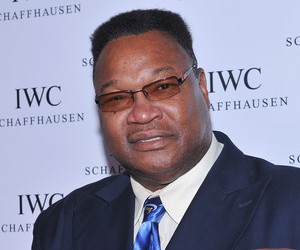 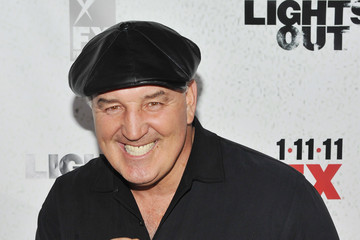
|
